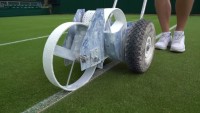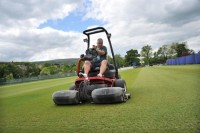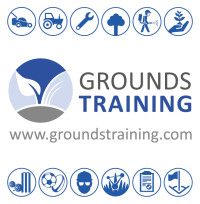
It is important to provide safe and consistent playing surfaces. This will only be achieved with regular ongoing maintenance regimes. It is important to keep the surface clean and free from any debris.
Key Tasks for August

Prior to mowing, the surface should be thoroughly brushed. Continue to brush courts daily to remove moisture from the grass surface, stopping the spread of disease and facilitating an improved quality of cut on the dry grass.
Other important tasks:
- It is important to roll the courts to firm them up; rolling should be done during favourable weather conditions, ideally when the soil profile is malleable/moist enough to bind together.
- It is important to monitor the condition of the court and constantly repair any bare and uneven levels. Topdress with compatible loam soils and overseed with a good quality ryegrass at a rate of 35-40 grams per m2.
- It is also the players responsibility to ensure they are wearing appropriate footwear and using balls that are not damaged.
- This month sees the continuation of regular maintenance tasks - grass cutting, grooming, brushing, aerating, feeding and watering. Particular attention should be made to your irrigation regimes, ensuring that all turf surfaces receive adequate amounts of water to maintain growth.
- Groundstaff will also be trying to maintain the sward height at between 6-10mm depending on the level of play. .
Mowing. The mowing height on the courts should be lowered to around 6-10mm for the playing season, subject to local weather conditions, but remember not to remove more than 1/3 of total grass height in each cut.
Mowing frequency will be dependent on a number of factors, grass growth, sward type, level or standard of facility, resources (staff and machinery) but, generally, it may vary from daily, in the case of Wimbledon, to two to three days a week, or even weekly, depending on resources available.
Grooming and verticutting are operations that remove unwanted side grass growth and reduce the amount of debris in the sward. These operations are carried out on a regular basis, often weekly or fortnightly, and providing you have sufficient watering facilities. These operations are completed in conjunction with your mowing regimes.
Aeration. A programme of aeration can be considered to alleviate any compaction from recent play. However, this needs to be done with an appropriate aerator, something like the Hydrajet, Dryject or SISIS Javelin Aeraid, which are able to penetrate the hard clay soil profiles without causing surface disruption, thus allowing some much needed air exchange to promote a second phase of grass growth.
Irrigation. It is essential to have water available for irrigation purposes. Irrigation is required for court preparation and repairs. Ensure that the water gets down into the rootzone, a minimum of 150mm, to encourage deep rooting. Check with a probe.
Fertiliser. Fertiliser treatment and turf tonic can be continued in accordance with your annual programme. If you haven't got a fertiliser programme, have your soil tested; try an independent soil analysis company for an impartial set of results.
In recent years, we have seen a change in feeding habits in professional sport, with more groundsmen resorting to a more detailed feeding programme using a concoction of fertiliser products and soil conditioners to maintain plant health.
This has generally been achieved applying a range of different products in the form of granular and liquid forms.
We are now seeing granular products being used as base/slow release feeds and being topped up with a range of liquid feeds that include bio stimulants along with micro nutrients. To help improve the performance of these feeds, a number of soil additive products and wetting agents are in regular use.
However, for a majority of smaller clubs/facilities, they will be reliant on a trusted base fertiliser, a 12:0:9, 7:0:7 or similar compound blend, or apply a slow release fertiliser to see you through to August. The choice of material and how well it works will be dependant on factors such as soil type and weather, with moisture and soil temperature being the catalyst for growth.
The performance of slow release fertilisers can be influenced by the weather, often producing a flush of growth when you least expect it. Some grounds managers may use straight compound granular or liquid fertilisers which activate when in contact with moist soil conditions, effectively stimulating grass growth within days.
Marking is important. Lines need to be clean, straight and accurate; ensure your marking machine is cleaned and serviced, checking that all the components are working properly. There is nothing worse than using a marker that drips and produces poor line quality. It will reflect on your workmanship. Remember to use string lines for accuracy. Also invest in a good quality paint products, there are plenty to choose from that will suit your requirements and budget. Linemarking Training Courses




The vagaries of the climate drive all factors with regard to turf management, and increasingly we see extremes of rainfall and dryness with the apparent turnaround from one to the other being short and dramatic.
This places increasing pressure on sports turf ecosystems in the form of biotic and abiotic stress. As a result, it is increasingly important that turf managers are seeking alternative strategies and techniques to mitigate against the effects of these stress factors upon the playing surface.
Warmth and humidity will be sure to activate a number of fungal diseases, from take-all patch, microdochium patch, dollar spot, anthracnose, waitea patch, fairy rings, leaf spot and red thread. Successful management of each disease requires knowledge of the contributing factors and considered, planned proactive treatment;
Increasingly, Integrated Turf Management should be applied to all situations. Practically this may look like the following
Monitor - historic site data – disease predictors e.g. Syngenta’s Greencast – five day weather forecast
Identify - correctly identify the disease, learn about the life cycle and contributing factors.
Plan - create disease management plans predict and mark high risk windows using data from monitoring process – hold stock or treatments.
Do - apply calcium, phosphite and silicon ahead of suspected activity periods. Use your data and monitoring to time fungicide treatments BEFORE you see active disease.
Record - periods of susceptibility, outbreaks, details of treatments.
Review - the success rate, how things responded to different treatments, assess how things can be refined. Short examples for each may include:
Controls and Management Techniques:
Take-all patch – check manganese levels and apply as a little and often foliar treatment - target roots with fungicide.
Microdochium patch - remove leaf wetness, do not promote soft growth.
Dollar spot – avoid low fertility, remove dew.
Anthracnose – avoid stress through drought or low fertility, secondary effect from nematode feeding.
Waitea patch – minimise thatch, improve surface drainage.
Fairy rings – assess for hydrophobic areas in the profile by dropping water down soil cores, target with wetting agents.
Leaf spot – remove dews, do not overfeed with nitrogen, plant resistant cultivars.
Red thread – remove dews, feed to grow out, plant resistant cultivars.
Surface abrasion can facilitate the infection of diseases, so a well-timed systemic fungicide can help to prevent attack.
Nutritionally speaking, maintaining plant vigour without promoting excessive growth is as always the key thing to aim for. It is not too late for a good quality organic based fertiliser which should give consistent results for up to eight weeks. The organic sources will also help to promote and support soil microbiology as we head towards autumn.
Continue wetting agent programmes to facilitate effective moisture management throughout the profile. Seek out evapotranspiration rates during hot spells and irrigate in millimetres not minutes. Your irrigation engineers should be able to provide the relevant information for your sprinklers.
August is peak season for the proactive control of Leatherjackets and chafer grubs with Entomopathogenic nematodes, Considered application as part of an integrated turf management plan, accompanied by a penetrant wetting agent and plenty of available moisture both before and after application will help to get the best out of nature’s practical answer to this problem and prevent issues come spring 2018.

Red thread and a number of other turf grass diseases may be seen after the recent changing weather fronts, conditions have been ideal for this disease. Grass plants are under stress, favourable temperatures for incubation, overcast and moisture in the ground enables the disease to spread quickly. The disease has come in because the grass plant is under stress, quite often due to the fact that it may be under-nourished. In most cases red thread can be controlled with an application of fertiliser.
If the outbreak is severe, then treatment is likely to be necessary. Choice of a curative or eradicant fungicide, preferably with a systemic action, is most suitable. Protectant types can take time to work and seem less effective on aggressive red thread strains. This must be a last resort, as the costs of annual applications of fungicides to large areas are very high and may eventually lead to pathogen resistance.
Control should be a mixture of good sward management, good observation and use of cultural controls. Occasionally, the bottle (or box) needs to be reached for to keep sanity and the sward alive.
A dose of feed or, in some severe cases, an application of fungicide will help treat the problem.
Please note: More information on these and many others can be found here: https://www.pitchcare.com/useful/diseases.php
It is important to keep you mowers clean and sharpened, adjusting/checking your height of cut on a daily basis.
Keep machinery in good order, clean after use and top up any oil / fuel levels.
Check cutting cylinders are at correct cutting height and are sharp.

We have one day LANTRA accredited LINEMARKING COURSES being held:
Wednesday 23rd August, Basingstoke RG21 3DR and
Wednesday 30th August, Ferndown, Dorset BH22 9EN
Some of the other courses available are:
- Chainsaws - CS30 and CS31
- H&S Refresher Training on Combined Turf Care Equipment; Tractors and Trailers; All Mowers (Ride-on and Pedestrian)
- Machinery Courses on ATVs; Tractors: Brushcutters/Strimmers; Mowers (ride-on and Pedestrian)
- Pesticide Application (PA courses)
- Stem Injection of Invasive Species (Japanese Knotweed etc.)
- Basic Trees Survey and Inspection
More details about all the courses can be found on our new Grounds Training website, or you can email Chris Johnson for information.
Many artificial, sand filled courts are not cleaned regularly, mainly due to the fact that they were sold, mistakenly, as maintenance free facilities. However, these courts require regular brushing and cleaning to keep the pile upright and prevent contamination of the sand infill materials.
Artifcial courts. Keep surface clean with regular sweeping and brushing. Remove any algae and moss from surface. Sand filled systems require regular brushing to maintain manufacturer's recommendations on sand levels and pile heights.
American Fast Dry courts. Keep surface clean, rolling to consolidate surface, levelling and brushing of fast dry materials, brushing to clean lines.
Clay courts. Keep surface clean, regular sweeping and brushing to restore playing levels using SISIS Trulute or similar equipment. Topdress any hollows or damaged areas. Repaint lines.
Tarmacadam. Keep surfaces clean, regular sweeping and brushing. Repair any hollows or damaged areas. Repaint lines.


